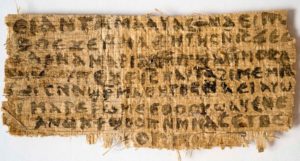The Verdict is in: Jesus Wife Papyrus Authentic!
A controversial, unique artifact referring to Jesus’ “wife” has just been authenticated.

The story began at the International Coptic Congress in Rome, September 18, 2012. At the congress, Prof. Karen King of the Harvard Divinity School unveiled an incredible find – a fragment of a gospel in which Jesus is referring to someone – most probably Mary Magdalene – as his “wife”. The fragment is written in ancient Sahidic, a dialect of Coptic. Papyrus texts written in this language were produced almost exclusively in Egypt between the 3rd century CE/AD and the 10th century, when papyrus fell out of use. Egypt, of course, was one of the homes of early Christianity, once it migrated out of the land of Israel.
Prof. King martialed high power academic support for the authenticity and importance of the find, including professors Roger Bagnall, AnneMarie Lujendijk and Ariel Shisha-Halevy. More than this, she had documents in her hand, dated to 1982, from Prof. Peter Monroe, a German Egyptologist who had shown it to his colleague, Egyptologist Gerhard Fecht, at the Free University in Berlin. Fecht had concluded that this papyrus “is the sole example of a text in which Jesus uses direct speech with reference to having a wife”. Fecht also believed that “this could be evidence for a possible marriage”.
You can imagine the howls that accompanied the revelation. Immediately, the sleeper agents of Pauline Christian Orthodoxy, masquerading as objective scholars, ran to the media and began blogging that King, Bagnall, Lujendijk and Shisha-Halevy had fallen for a modern forgery. The good professors were not forgers, the critiques said, just fools who had fallen for a forgery. Not being used to the media, and not being controversial, King was not expecting this kind of derision. She dove under her bed and disappeared for almost 2 years. But she wasn’t totally inactive. She eventually resurfaced and quietly went to an army of experts to do the science that she should’ve done in the first place.
I have written 7 blogs about this. In all of them, I stated without hesitation, based on the evidence, that the finding was authentic beyond question. But, given the sensitivity of the subject matter, more science had to be done on the papyrus, the ink, etc. Especially since, after the outcry, Harvard Theological Review spiked Prof. King’s paper and Smithsonian Television delayed airing the companion documentary to her revelation.
Now, after nearly 2 years of studies, the verdict is in and the long awaited paper by Prof. King has been published. The conclusion: “the scientific testing completed thus far consistently provides positive evidence of the antiquity of the papyrus and ink, including radiocarbon, spectroscopic, and oxidation characteristics, with no evidence of modern fabrication.” Hallelujah!
So what can we learn from this fragment of a previously unknown gospel? Despite authenticating the papyrus, Prof. King is worried about the theological implications of her find. As a result, in the first paragraph of her paper, she states: “the fragment does not provide evidence that the historical Jesus was married.” Really? You have a fragment of a gospel where Jesus calls a woman his “wife”, and this says nothing about his marital status? Good grief.
Prof. King has also repeatedly stated that the new “Jesus Wife” gospel simply demonstrates that in early Christianity there were two groups: one believed that Jesus was married, and the other believed that he was not. Wanting to be objective, Prof. King says that neither position is historical. I guess they don’t teach logic at the Divinity School because one of the two positions has to be historically accurate. Professor, I don’t know how to break this to you, but Jesus was either married or not married. One of these statements has to be true. The gospel referring to his “wife” is certainly evidence for one of the two positions.

(Alexander Ivanov, 1860)
So what does the gospel actually say? In 8 lines, reminiscent of the Gnostic Gospels of Philip and Mary Magdalene, Jesus refers to his mother as the one who gave him “life”. He also refers to another “Mary”. This “Mary” was being denied access to the earliest Jesus entourage. She was deemed not “worthy”. In her defense, Jesus says she is “my wife”, and he announces that “she is able to be my disciple”. For clarity, in line 7, he even goes so far as to say: “I dwell with her”. Since Jesus is not referring to his mother as his “wife”, he must be talking about the other Mary in his life – Mary Magdalene.
Case closed.
For more on the latest findings, see the New York Times.

